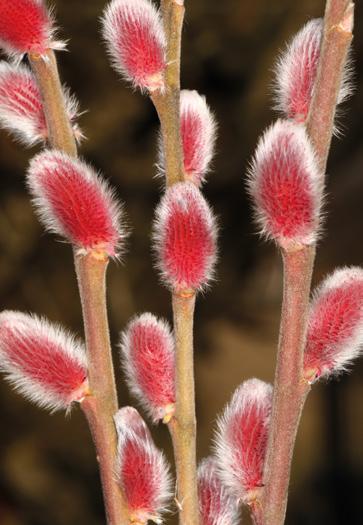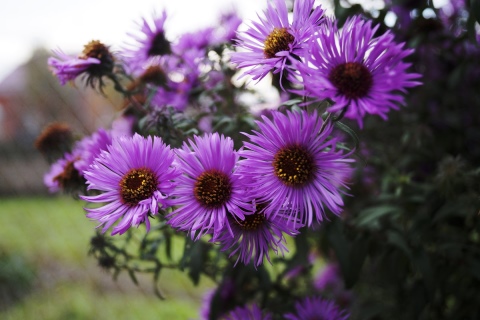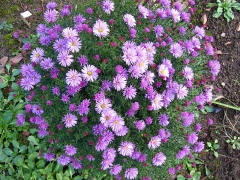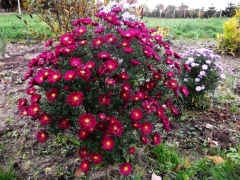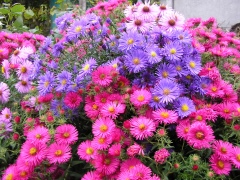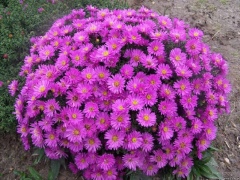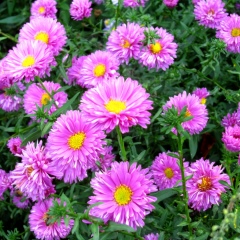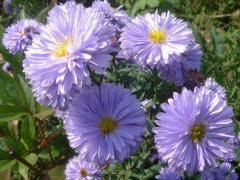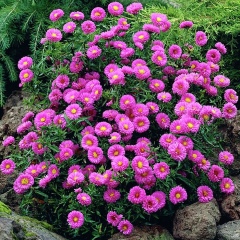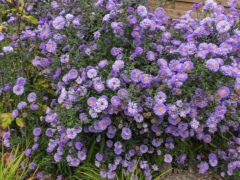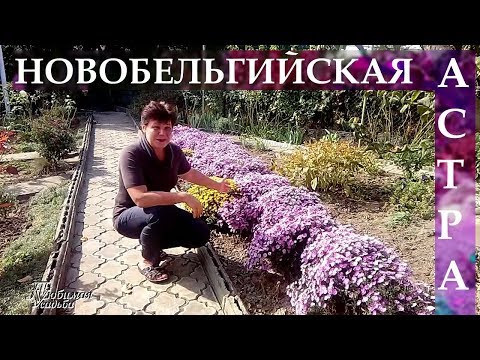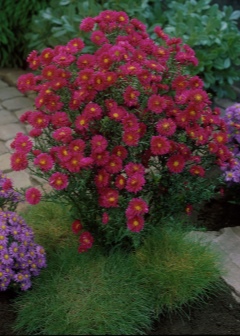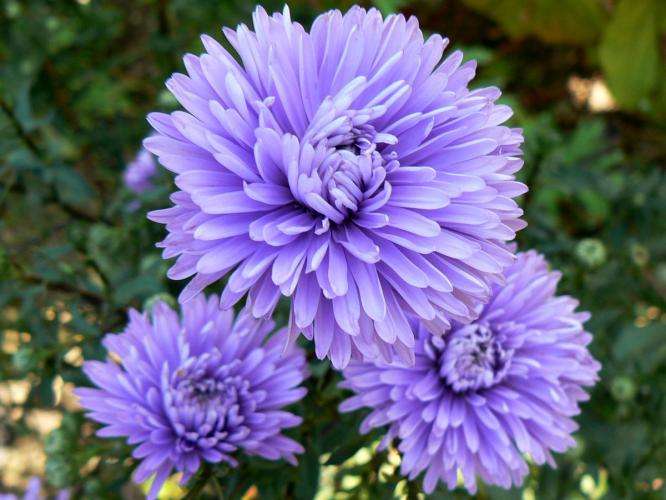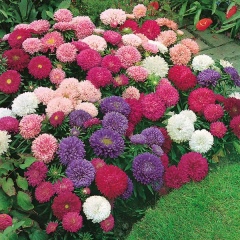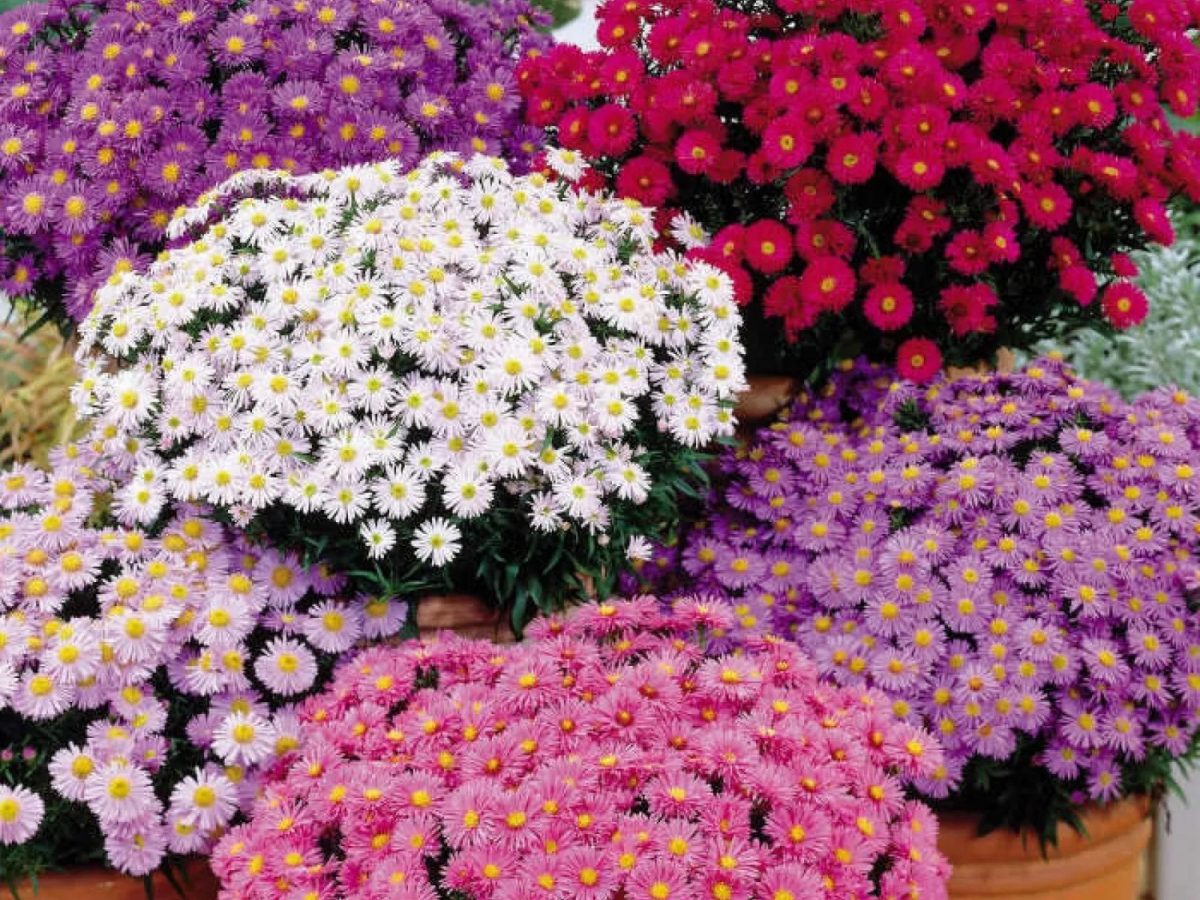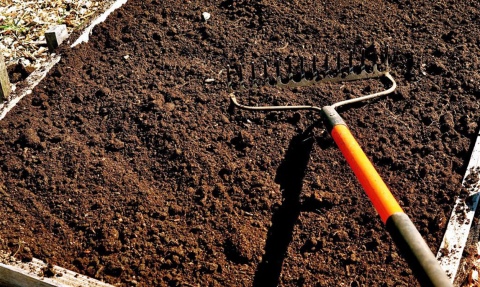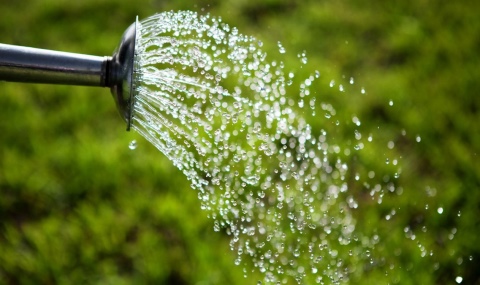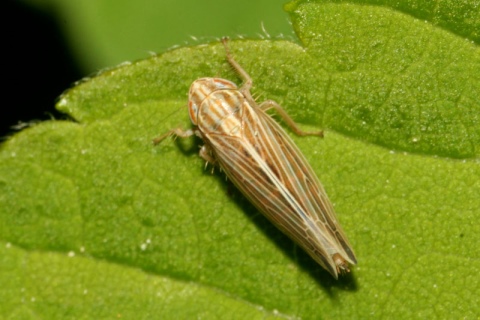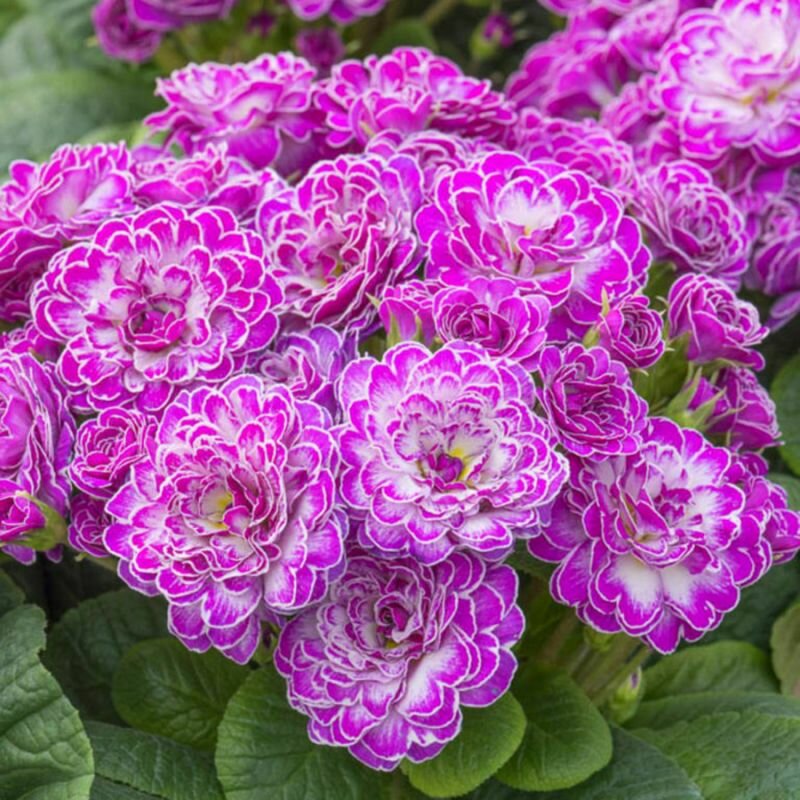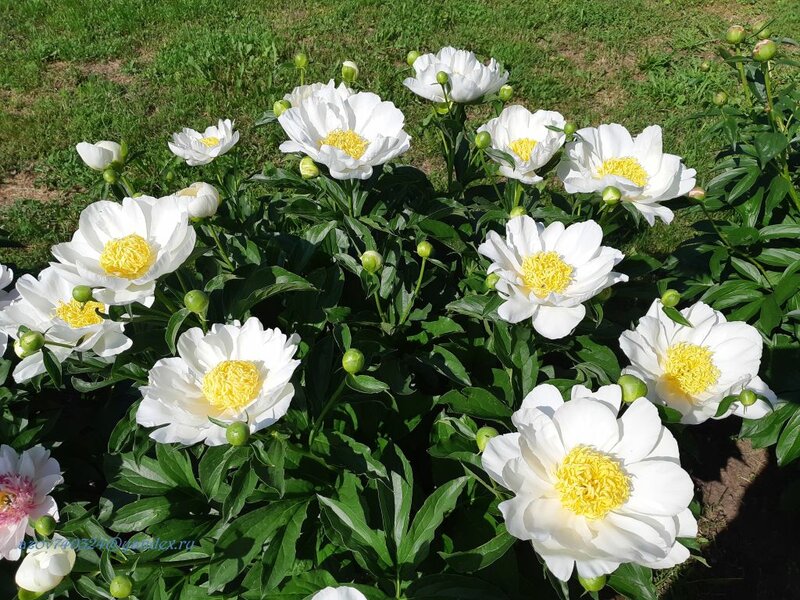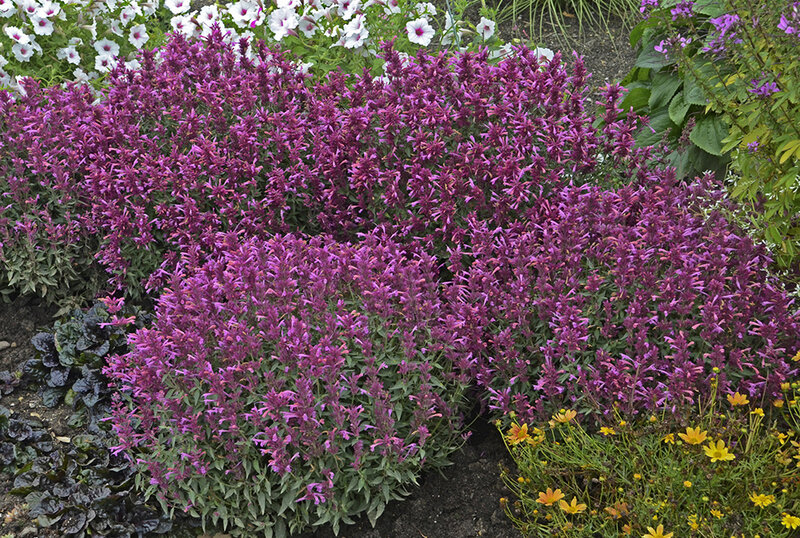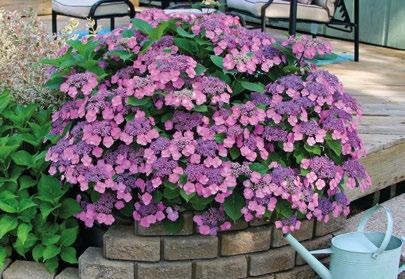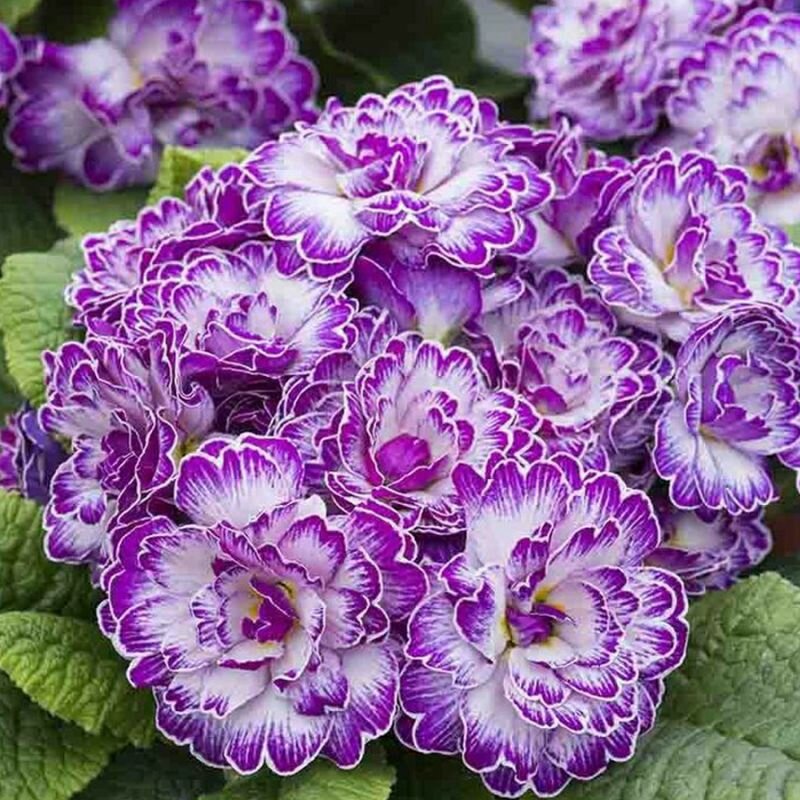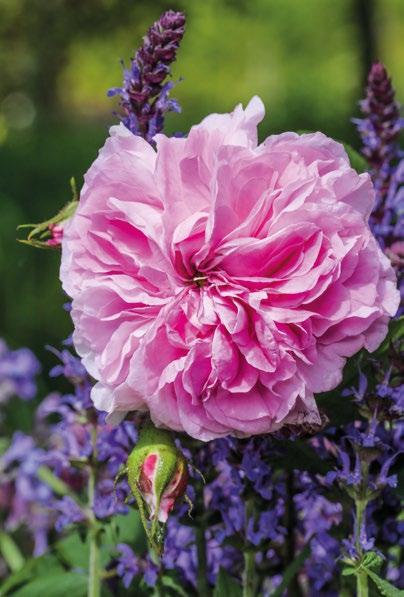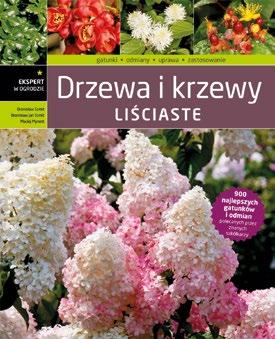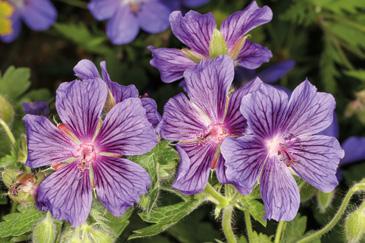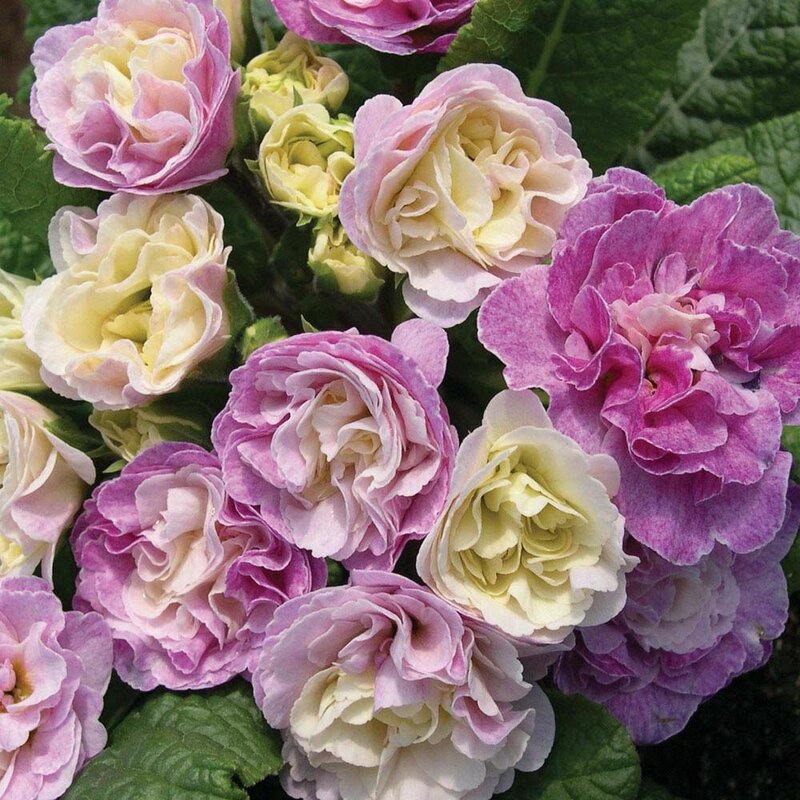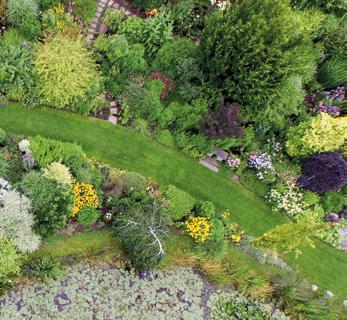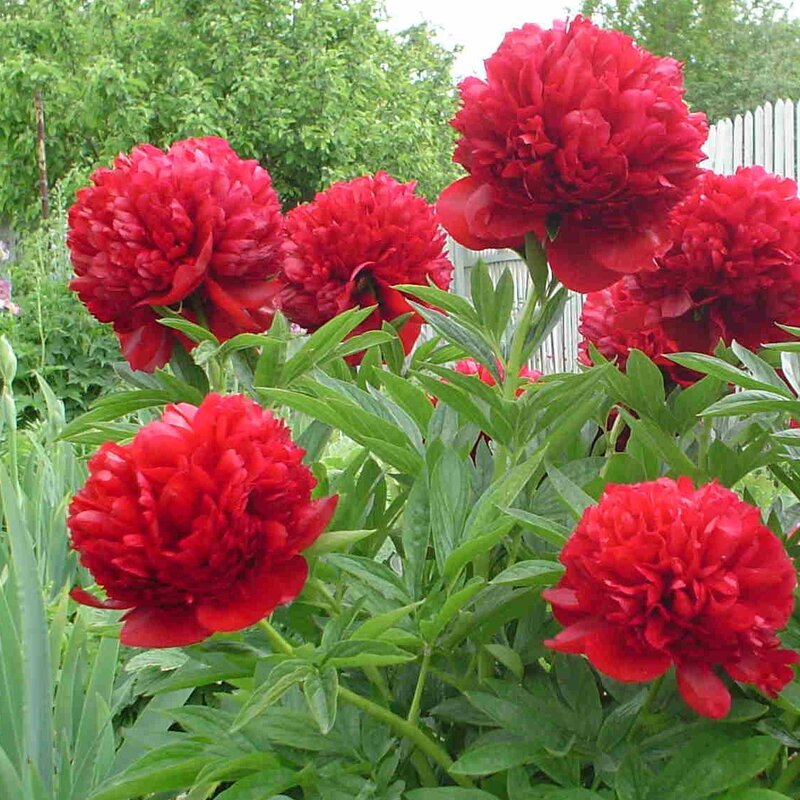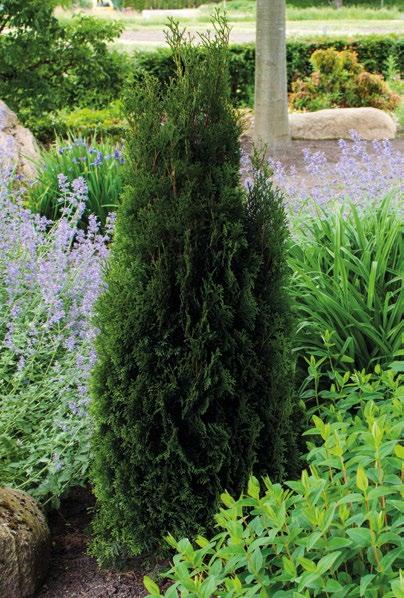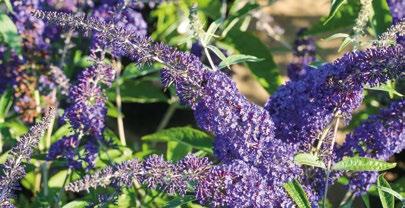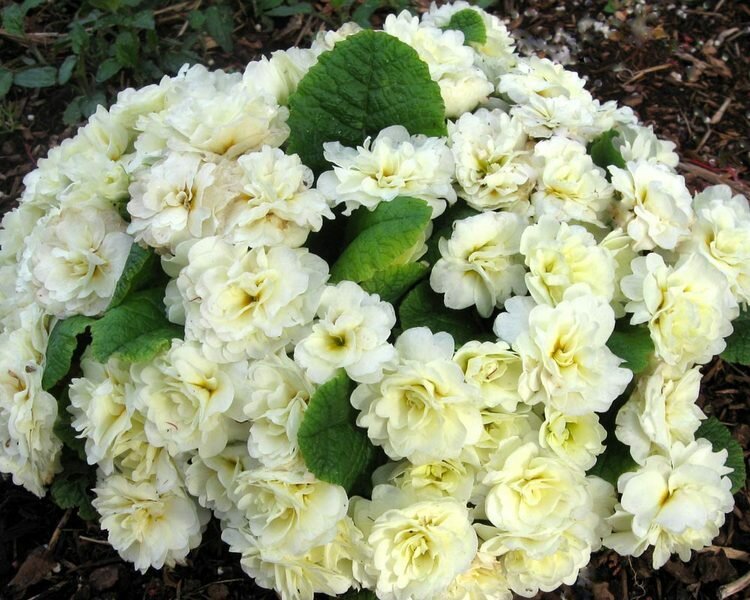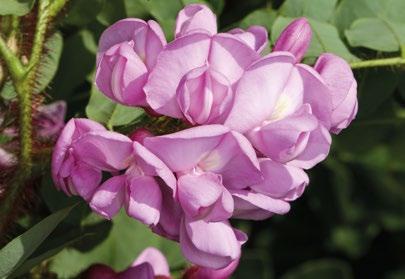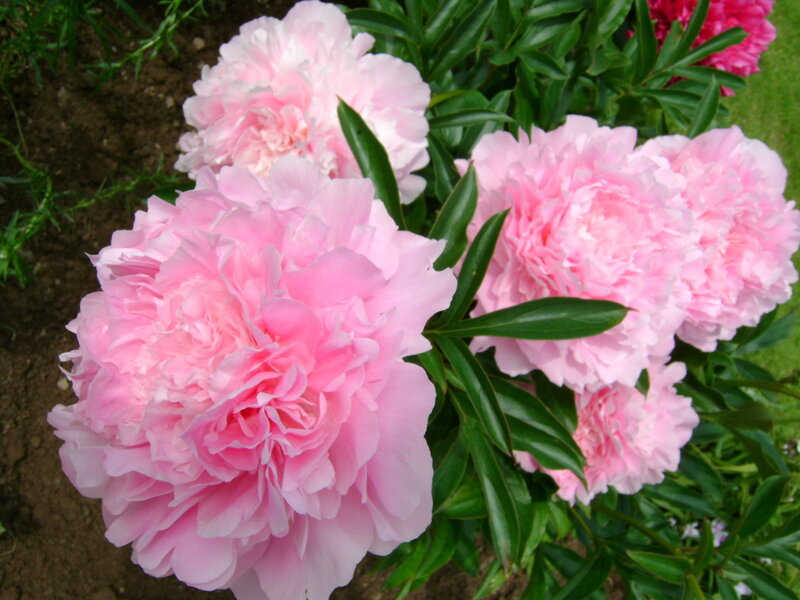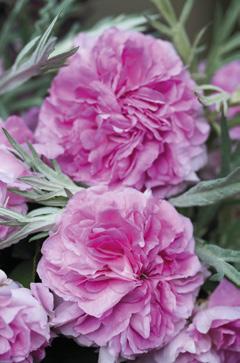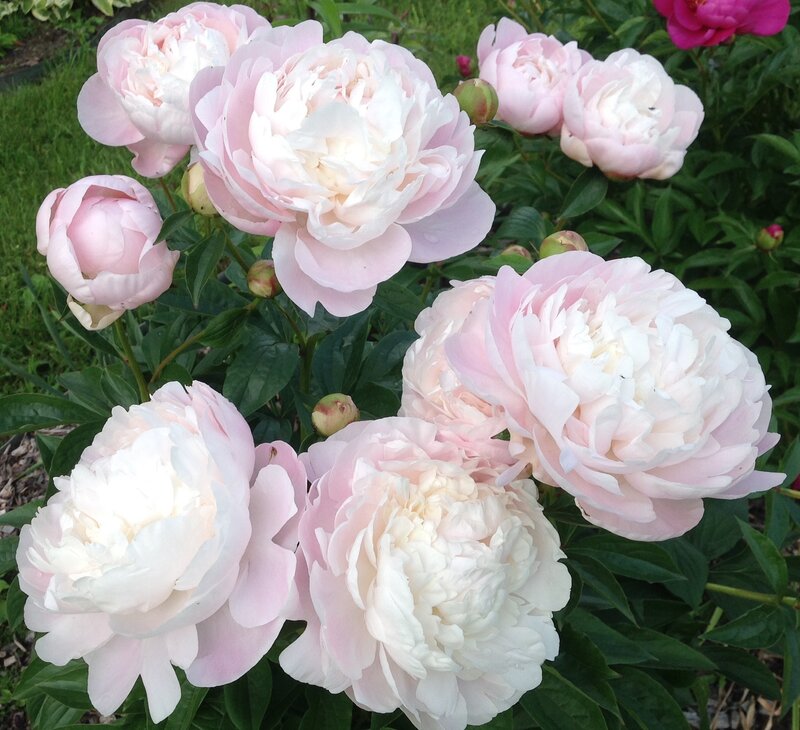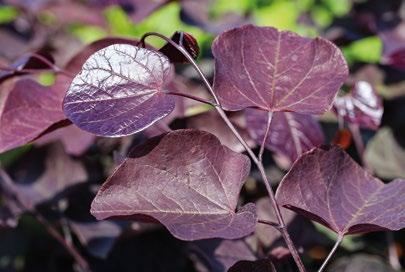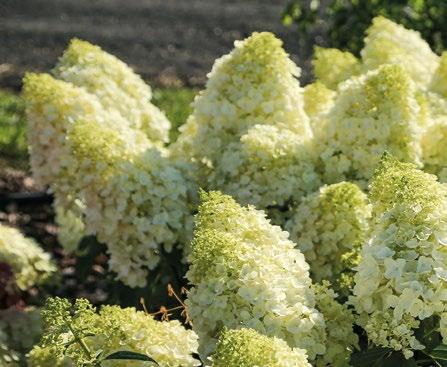Care
Novobelgian aster is an unpretentious plant, however, planting and caring for it must be carried out in accordance with all the rules of agricultural technology, and then it will reciprocate - it will give a lush and colorful flowering, pleasing to the eye even during the autumn weather.
Watering
Sentyabinka is quite drought tolerant. Usually during its flowering period there is a lot of rain.
It is very important not to overdo it with watering, so you can ruin the plant
During dry weather, watering should be plentiful, but not frequent. Water for irrigation should be taken settled, warmed to room temperature.

Top dressing
In spring and autumn, it is recommended to pour a small amount of humus under the bushes. During the season, 3 full dressings are made with superphosphate and potassium sulfate - 2 weeks after planting, during the period of bud formation and at the initial stage of flowering.
Mulching
The soil under the bushes of the New Belgian aster must be periodically loosened, weeds must be removed very carefully. It is recommended to huddle each bush and mulch the soil around with dry peat and sawdust, this prevents the soil from drying out quickly and the appearance of weeds and pests.

Reproduction
To obtain new plants of the Belgian aster, there are three methods of reproduction - by seeds, cuttings and dividing the bushes.
The seed method is used extremely rarely due to the duration and laboriousness, while varietal characteristics may be lost.
The most commonly used division of the bush. In the spring, overgrown bushes are dug out, the required number of parts are separated with a sharp knife. Large bushes can be divided without digging out entirely, but by cutting off the desired part of the plant with a sharp shovel.
It should be borne in mind that at least 5 shoots should remain on the plot. Then they are planted in the usual way in the designated place.
Cuttings are made from May to August by the usual method, and a month after rooting, seedlings are obtained.
Every 3-4 years the growing bushes of asters need to be divided to preserve the decorative planting. And every 6 years, it is advisable to change the planting site due to soil depletion.
Wintering
Astra Novobelgiskaya is famous for its high frost resistance. But young plants of the first year of life are recommended to be covered for the winter. To do this, you need to cut off the dry stems, then cover the soil surface above the roots with the help of spruce branches or sawdust.

In the spring, after the onset of stable warm weather, the shelter must be dismantled.
Disease and pest control
With poor care, aster can be affected by powdery mildew, rust and jaundice. For prophylaxis in the spring, it is necessary to spray the bushes with Bordeaux liquid, timely fertilize and loosen the soil.
Of the harmful insects, the most dangerous are spider mites, aphids, scoops and earwigs.
To prevent their appearance, it is necessary to observe the recommended distance between plants when planting, carefully weed weeds, remove dry stems and other debris from the garden. In case of insect infestation, you will have to use the appropriate insecticides.
7. Varieties and types of arabis:
7.1.Arabis alpine - Arabis alpina
Plants are native to southwestern Europe, from the Mediterranean. This flowering perennial reaches a height of 20 cm, bushes grow up to 1 m in diameter. Leaves grow all year round, flowering occurs in April-May, and the seeds ripen in June-July.
7.2.Arabis Caucasian -Arabis caucasica
This species is often regarded as a subspecies of Alpine Arabis. In nature, plants are found in the Caucasus, Turkey, and the Crimea. Perennial herb up to 30 cm high.with finely toothed, oblong - oval leaves. The flowers are large enough, reaching a diameter of 1.5 cm.
7.2.1. Caucasian Arabis Little Treasure Deep Rose - Little Treasure Deep Rose
A charming variety of Caucasian Arabis with bright, pink flowers that adorn plants in April - May.
7.3. Arabis ferdinandi-coburgii
Ground cover perennial up to 20 cm high with entire, oblong - oval leaves, often having a so-called variegated color. On the leaf plates, white or yellow stripes run along the edge.
7.4.Arabis ciliate-leaved - Arabis blepharophylla
An American species characterized by bright lilac or pink buds that form in spring and remain attractive for several weeks. The leaf blades are covered with tough, straight hairs.
7.5. Arabis androsacea
Low-growing decorative perennials that resemble moss. The leaves are green, collected in small whorls, covered with long white pubescence. The flowers are simple, white, funnel-shaped, collected in dense inflorescences at the tops of the peduncles.
7.6. Arabis suendermannii - Arabis suendermannii
Bushes up to 10 cm high with dark green, glossy, oval leaves, collected in small rosettes. In April - May, plants adorn themselves with small white flowers with oblong petals.
7.7. Arabis kelleri
The species has small earnest rosettes of dark green leaves with contrasting white pubescence. During the flowering period, it produces stocky vertical peduncles with white buds.
7.8 Arabis procurrens
Evergreen or semi-evergreen in more severe climates, perennials with thin, erect peduncles and loose inflorescences of white, fragrant buds.
7.9 Arabis Funkii
Pointed leaf blades of this species are collected in basal rosettes and covered with long, sparse, light pubescence. Peduncles are tall, numerous, with white buds at the tops.
7.10.Arabis Arends - Arabis х arendsii
Miniature flowering perennials up to 10 cm high with rounded bushes. During the flowering period, the foliage is almost completely hidden under the numerous buds of white, pink or lilac.
7.11. Arabis bryoides
A species with creeping shoots, on which compact leaf rosettes are formed from dark leaf plates. Numerous large, white flowers contrast well with the dark leaves.
7.12. Razuha Nordman - Arabis nordmanniana
This species became widespread in Turkey, the Caucasus and Georgia. Sufficiently tall plants of this species reach 30-50 cm and have glossy leaf blades with small denticles along the edge. On the tops of strong shoots are rounded umbrellas with white flowers.
You may also be interested in:
Growing shrub asters
To breed this culture, it is necessary to choose areas where there is enough sunlight, and at the same time there is also shade from the trees. It is unacceptable to grow asters in swampy ground. Stagnant moisture is the cause of the premature death of the bush. Before planting the plant directly, it is necessary to prepare the soil for its adaptation and further growth. Light air-permeable soil is optimal for growing asters. It is necessary to pre-dig and fertilize the soil with organic and mineral fertilizers. To eliminate high acidity, liming is necessary. To reduce the excessive moisture of the earth, sand is additionally added to it.
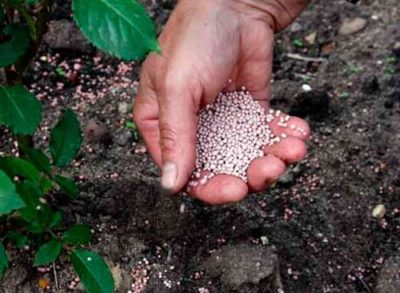
Perennial aster reproduces in the following ways:
- seeds;
- dividing the root system of the bush;
- reproduction by vertical layers;
- by cuttings.
The first method of growing a flower is rarely used due to the poor development of the bushes and incomplete inheritance of maternal traits. The autumn season is optimal for the introduction of seeds into the soil.With the onset of the warm season, the emergence of seedlings is observed, which must be watered and fed throughout the season, and then transplanted to a permanent place in the fall.
For cultivation of flowers by dividing the root system, adult plants of at least 4 years of age are used. It is recommended to carry out this procedure in the spring before the swelling of the kidneys. The transplant is carried out by digging and dividing the root system of the bush. It is necessary to carefully clean it from the soil, and then separate the old roots from it. The plant is separated so that the new bush contains a developed root system and at least 3 healthy stems. The optimal stay of an aster in one place is 5-6 years, and therefore, after separation, both flowers need to be transplanted to new areas.
For the propagation of asters by vertical layers, adult healthy plants are used. This method is acceptable for shrubs growing on properly manicured and fertilized soil. It is necessary at the end of the growing season of the aster to remove all shoots, leaving a bush up to 10 cm high. With the onset of spring, it is necessary to spud it so that it is completely under the soil layer. Manipulation is carried out until the flower reaches a height of 25 cm, after which it is looked after in a standard way until the end of the warm season. In late autumn, before the onset of cold weather, you should dig up the plant and separate the resulting layers from it with the root. After that, they are transplanted to a permanent place, and in the next spring-summer period, the hilling and care procedure is repeated. Flowering of asters grown in this way should be expected no earlier than 2 years after transplanting.
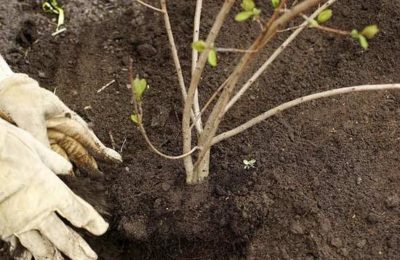
The most used method of breeding shrub asters is cuttings. This method consists in separating the upper shoots of the plant and planting them in the ground. It is necessary to carefully cut the stalk off the bush at an angle, and then separate the upper part from it, which is higher than the first bud. The resulting shoot is placed in a solution to stimulate growth and better adaptation for 15 hours. After that, it is kept in a container with water until it is introduced into the ground. Cuttings of asters are carried out in greenhouses or under a film stretched over a frame. The planting site should be a layer of soil and drainage. To do this, it is necessary to prepare a composition of turf, sand and peat with a ratio of 1: 2: 2, which is covered with perlite or a combination of sand with vermiculite. Cuttings are introduced into the soil at an inclination up to 10 cm deep at a distance of at least 5 cm from each other. The formation of a strong root system with this method of breeding asters occurs within a month.
How to plant?
Before you start growing a starlet, it is recommended that you familiarize yourself in more detail with the features of planting a flower. A huge advantage of a decorative perennial is its simplicity. Almost any soil is suitable for the plant. Therefore, even a beginner in gardening can cope with planting and growing Astrantia.
First you need to choose a variety for planting and study its features. It is recommended to plant seedlings in open ground in May-June. A perennial can grow both in well-lit areas and in the shade. It all depends on the selected variety. Sun-loving plants, growing in a suitable area, have a healthy and beautiful appearance. Their inflorescences become large, and their color is saturated.
Due to the compactness of the rhizome, Astrantia does not need a deep fertile soil layer. The plant must be provided with a small growing area, which will be characterized by nutritious and loose soil.
Astrantia is suitable for both group and solo boarding. Therefore, for the first method, a certain distance between plants was established when planting in open ground. The seedlings are placed in a planting hole and covered with earth to the root rosettes. Then the soil is compacted and moistened. Watering should be abundant.
Astrantia does not need insulation, as it perfectly tolerates low temperatures. However, in areas with a harsh climate for the winter, the plant is mulched with a thick layer of peat. The perennial grows very quickly, therefore, after a year of life, the formation of dense thickets is observed.
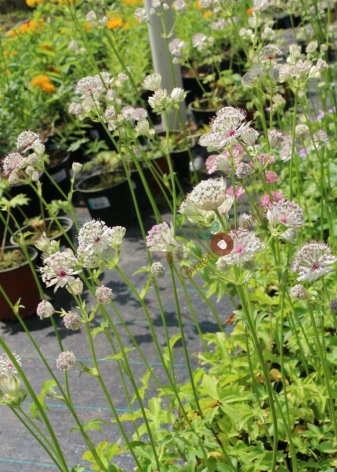
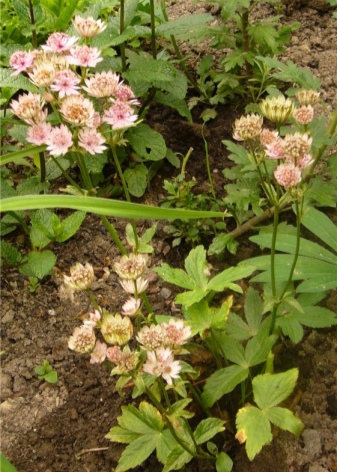
Popular varieties in gardening with photos
Since the 17th century, when the New Belgian aster was brought to Europe from North America, breeders have not ceased to breed new hybrid forms. Today, the assortment of autumn perennials has more than a thousand items. The most popular among Russian summer residents are:
- Oktoberfest It grows up to one meter, blooms with lilac-blue semi-double baskets. Outwardly it resembles Scotia, Purple Dome or Marmara.
- Marie Ballard (Marie Ballard). Tall cultivar, characterized by large (about 80 mm) lavender inflorescences.
- Henry Blue (Henry Blue). A relatively new hybrid, no more than 0.4 m in height. It blooms with double buds of a rich violet-blue color scheme. It is similar in color to the Bengale variety.
- Friendly. A tall shrub up to 1 m in size. During flowering, it is covered with large semi-double baskets of pink shades. Outwardly similar to the cultivar Oman or Egge.
- Aden (Aden). Tall aster blooming with lush white inflorescences about 50 mm in size.
- Red. A compact plant about half a meter high. Blooms in raspberry or carmine baskets with a diameter of 30-40 mm.
Pest and disease control
Of the diseases, asters are most susceptible to:
- powdery mildew;
- rust;
- verticillary wilting.
To avoid and get rid of them will help:
- Correct agricultural technique.
- The qualitative composition of the soil.
- Treatment with special chemicals for disease control.
And the most common pests are:
- aphid;
- ticks;
- slobbering penny;
- acaricides.
From the appearance and to get rid of insects will help:
- Compliance with the timing and distance of planting seedlings.
- Digging a flower garden in the autumn.
- Fertilization.
- Removal of fading, dying parts.
- Special chemical agents are protected from pests.
Description:
Aster is one of the most popular plants. Many types and varieties of asters differ in height, color, flowering time, as well as care and application. Conventionally, they can be divided into high and medium-sized asters for flower beds and into undersized asters for rocky hills and low curbs. Asters are so varied in terms of flowering time that you can pick up varieties that replace each other in flowering from June to November. At the same time, caring for them is minimal. All asters grow quickly, so it is better to divide and plant them every 3-4 years. Location: in a sunny, warm place, does not tolerate dry soil. Soil: prefers fresh, fertilized soils, does not tolerate heavy soils! Planting: plants are planted at a distance. 20-40cm apart so that young underground shoots are covered with a 2-3cm layer of soil. Reproduction: by dividing the bushes in the spring. Flowering: from June to November. Use: look beautiful in group plantings on lawns, rocky areas and hills, suitable for cutting, especially tall varieties.
Novobelgian aster - stems from 50cm to 150cm tall, densely branched in the upper part, glabrous or hairy, depending on the variety. Leaves linear-lanceolate with obtuse bases, alternate, sessile. Inflorescences are large, paniculate, sometimes consisting of 200 baskets up to 2 cm in diameter. In some varieties, the reed flowers are arranged in several rows, completely covering the yellow tubular flowers, which gives the impression of doubleness. Under good soil conditions, this species blooms very profusely and for a long time from September. Bears fruit. The aster is planted in sunny places with protection from cold winds. Plants are hardy. It is better to plant them in early May. Low varieties are planted on an area of 20x25cm, and high ones require 40x45cm.Since the aster grows quickly, having a long rhizome, it is transplanted after 3-4 years.
Royal Ruby - plant height 100cm, dark red flowers.
Category: Other perennials
How the perennial aster virginiana reproduces
Gardeners often practice vegetative and bush propagation.
Dividing the bush
Every seven years, Belgian asters are transplanted to a new place in order to preserve the splendor and decorativeness of the buds. The bush is divided with a knife, all suspicious roots are immediately removed. Shoots on daughter bushes are pruned, parts are immediately transferred to a new place or placed in a container with water.

The bunch division procedure does not take much time
It is important to use clean inventory so as not to introduce fungal infection.
Cuttings
For border planting, plants are propagated by cuttings, cut from bushes, older than 5 years. Placed in water for rooting. After that, the cutting can be rooted in a new place.
Note! Leave up to 50 cm between plants.Thickened plantings are more likely to affect pests

